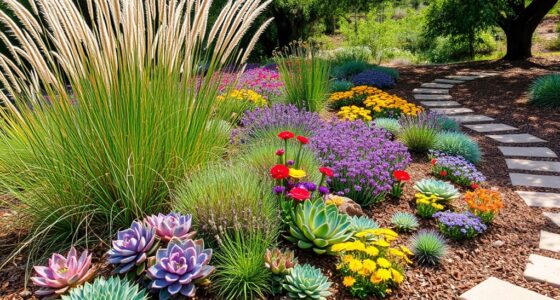Composting transforms kitchen scraps and garden waste into rich, healthy soil that benefits your garden and reduces waste. To get started, layer green scraps like vegetable peels with brown materials such as leaves or cardboard, and turn the pile regularly to keep it aerated. Keep it moist and avoid meat or dairy to prevent pests. To learn how to set up, maintain, and use compost effectively, explore these simple steps further.
Key Takeaways
- Composting transforms organic waste into nutrient-rich soil, reducing landfill waste and environmental impact.
- Use a balanced mix of green (nitrogen) and brown (carbon) materials, avoiding meats and dairy.
- Maintain proper moisture, aeration, and layering to promote microbial activity and efficient decomposition.
- Regularly turn compost to enhance aeration, prevent odors, and accelerate composting.
- Finished compost enriches soil, improves plant health, and supports sustainable gardening practices.
Understanding the Benefits of Composting
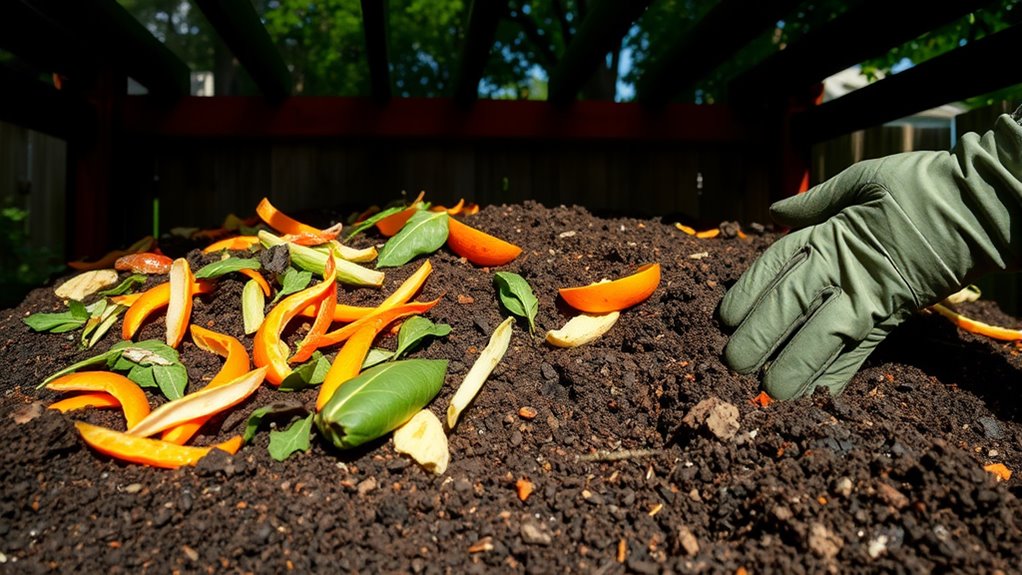
Have you ever wondered how composting can positively impact your environment and garden? Many people believe composting is complicated or attracts pests, but these are just composting myths. In reality, composting reduces waste sent to landfills, which decreases methane emissions—a major environmental impact. It also enriches your soil naturally, promoting healthier plants and reducing the need for chemical fertilizers. By composting, you’re helping to lower your carbon footprint and support sustainable practices. The process turns organic scraps into nutrient-rich soil, benefitting both your garden and the planet. Understanding these benefits shows that composting isn’t just good for your garden; it’s a simple way to make a meaningful environmental impact. So, don’t let misconceptions hold you back from starting your composting journey.
What Materials Can Be Composted
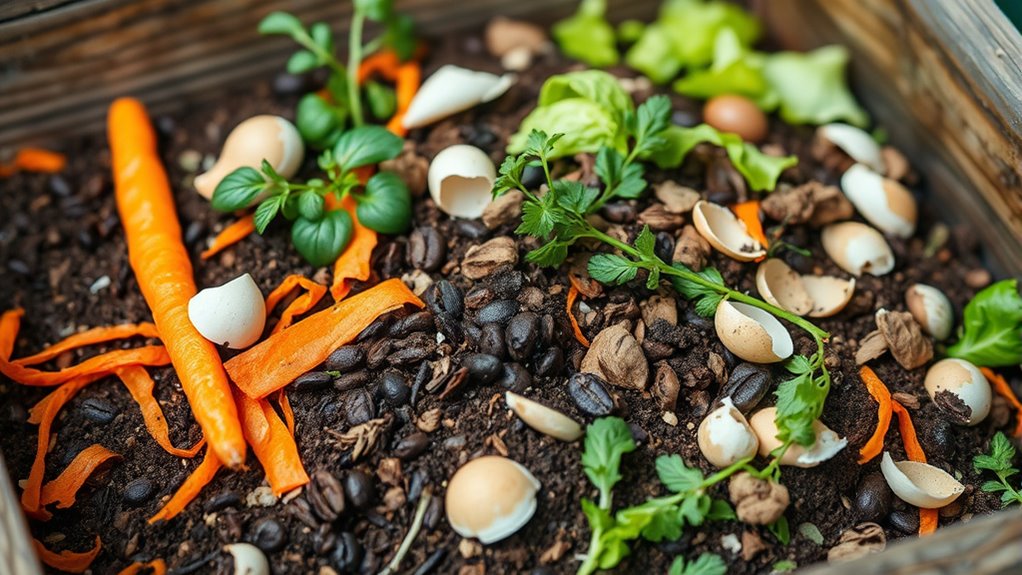
You can compost food scraps like vegetable peels and coffee grounds, which break down easily. Garden and yard waste such as leaves, grass clippings, and small branches also make great additions. By including these materials, you help create rich, healthy compost for your garden. Incorporating sound vibrations into composting practices is also believed to enhance microbial activity and nutrient breakdown.
Compostable Food Scraps
Compostable food scraps include a variety of natural materials that break down easily in a compost pile. These scraps are an excellent source of nutrients and help create rich soil. When adding compostable food scraps, focus on items like edible peelings, which decompose quickly and add flavor and nutrients to your compost. You can also include:
- Fruit and vegetable scraps
- Coffee grounds and filters
- Eggshells
- Nut shells
- Bread and grains
Avoid meat, dairy, and oily foods, as they can attract pests and slow down decomposition. Properly managing these scraps guarantees a healthy balance of green and brown materials, leading to high-quality compost. Remember, the more diverse your food scraps, the richer your compost will become. Additionally, understanding the importance of contrast ratio can help you optimize conditions for decomposition and ensure a balanced environment within your compost pile.
Garden and Yard Waste
Garden and yard waste includes a variety of natural materials that break down easily in a compost pile, enriching your soil. You can compost garden waste like grass clippings, leaves, and plant trimmings, as well as yard debris such as small branches and shredded bark. These materials provide valuable nutrients, helping your compost become rich and fertile. Be sure to balance green and brown materials to keep the compost active and odor-free. Incorporating natural materials from your garden helps create a sustainable and effective composting process.
Setting Up Your Compost Bin or Pile
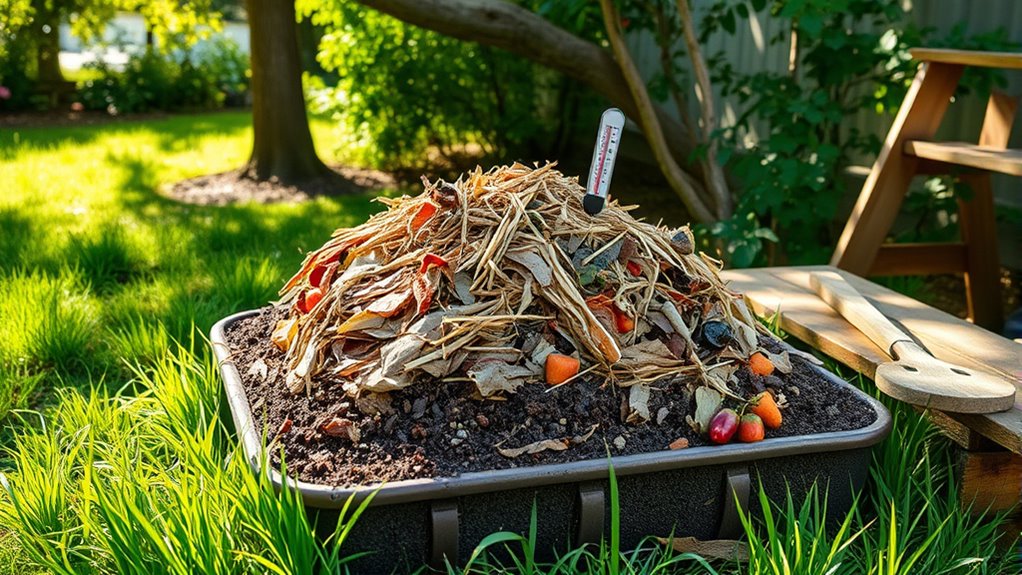
First, choose a spot that’s convenient and gets good airflow for your compost bin or pile. Next, pick a container that suits your space and needs, whether it’s a bin or a simple mound. Finally, aim for a balanced mix of green and brown materials to keep your compost healthy and active. To ensure proper decomposition, regularly monitor moisture levels and turn your compost to aerate it.
Choosing a Location
Choosing the right location for your compost bin or pile is vital to guarantee efficient decomposition and easy access. You’ll want a spot that balances sunlight exposure and shade considerations to maintain ideal temperatures and moisture. A solar location can speed up composting, but prolonged direct sun may dry out material or cause odors. Conversely, too much shade can slow decomposition. Select a site that’s near your kitchen for convenience yet away from your neighbor’s yard to avoid odors. Ensure good drainage to prevent waterlogging and avoid areas prone to flooding. Keep the bin accessible for turning and maintenance. Consider wind patterns to prevent drying out or dispersing odors. Proper air circulation will help maintain healthy compost conditions. Ultimately, a well-chosen spot will make composting easier and more effective.
Selecting a Container
Selecting the right container is essential to guarantee your composting process runs smoothly. You have various container types to choose from, including compost bins, tumblers, and open piles. Consider your space, budget, and how much effort you want to put in when choosing. Material selection is also key; plastic containers are lightweight and durable, while wooden bins blend naturally into gardens. Metal options resist pests but may rust over time. If you’re short on space, a tumbler provides quick mixing and easy turning. For larger setups, an open pile might suffice. Whichever type you pick, ensure it offers adequate ventilation and drainage. Proper container choice helps maintain the right environment for composting, making your journey from scraps to soil efficient and enjoyable. Additionally, understanding weather patterns can help you plan your composting schedule, especially in regions with extreme seasonal changes.
Balancing Green & Brown
Once you’ve picked the right container, the next step is to establish a healthy balance of materials inside it. Achieving the right mix of green materials and brown materials is *essential* for composting success. Green materials, like vegetable scraps and fresh grass clippings, provide nitrogen, while brown materials, such as dried leaves and cardboard, supply carbon. To optimize decomposition, aim for a balanced ratio, roughly 1 part green to 3 parts brown. Keep the pile aerated to prevent odors and encourage microbial activity. Regularly turning the compost helps distribute moisture and materials evenly. Remember, maintaining this balance speeds up composting, produces nutrient-rich soil, and reduces waste. Properly detecting passive voice in your writing can also make your instructions clearer and more direct. With careful layering and monitoring, you’ll create a thriving compost that turns scraps into healthy soil.
The Composting Process: How It Works

Have you ever wondered what happens inside a compost pile? It all starts with microbial activity, where tiny microorganisms break down your green and brown scraps. These microbes need oxygen flow to do their job effectively. As they digest organic materials, they produce heat, which accelerates decomposition. Turning the pile helps maintain oxygen levels, preventing anaerobic conditions that slow down the process. You’ll notice temperature increases as compost heats up, signaling active microbial activity. Over time, the microbes convert scraps into rich, dark soil. This natural process transforms your kitchen and yard waste into valuable compost for your garden. Understanding the importance of microbial health and oxygen flow helps you optimize the process and produce healthy soil more efficiently.
Maintaining and Troubleshooting Your Compost
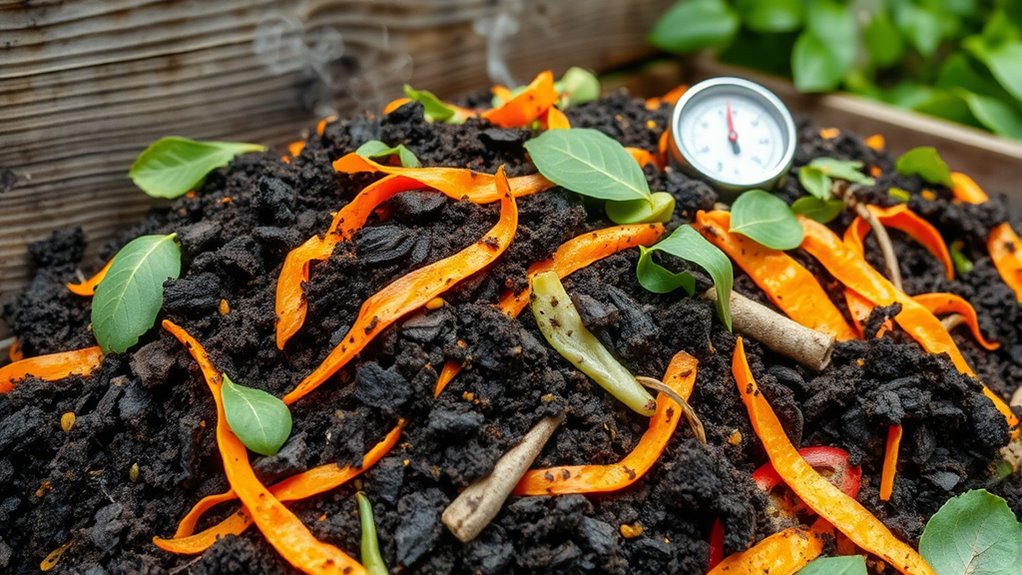
Maintaining your compost pile requires regular attention to keep it active and healthy. To troubleshoot issues, monitor moisture levels and guarantee proper aeration. If your compost smells bad, it may be too wet or compacted; turn it to improve airflow. Pest control can become a problem if food scraps aren’t buried or covered properly. Use a balanced mix of greens and browns to prevent odors and pests. Keep an eye on moisture—add dry materials if it’s too wet, or water if it’s too dry. Regularly turning the pile speeds decomposition and reduces pest attraction. Proper aeration and moisture control are also essential for maintaining effective composting systems. Here are some key tips:
Regularly turn and monitor moisture to keep your compost healthy and pest-free.
- Cover food scraps to deter pests
- Maintain moisture at a damp sponge consistency
- Turn the pile weekly for aeration
- Balance green and brown materials
- Check for foul odors and adjust accordingly
Using Your Finished Compost in the Garden
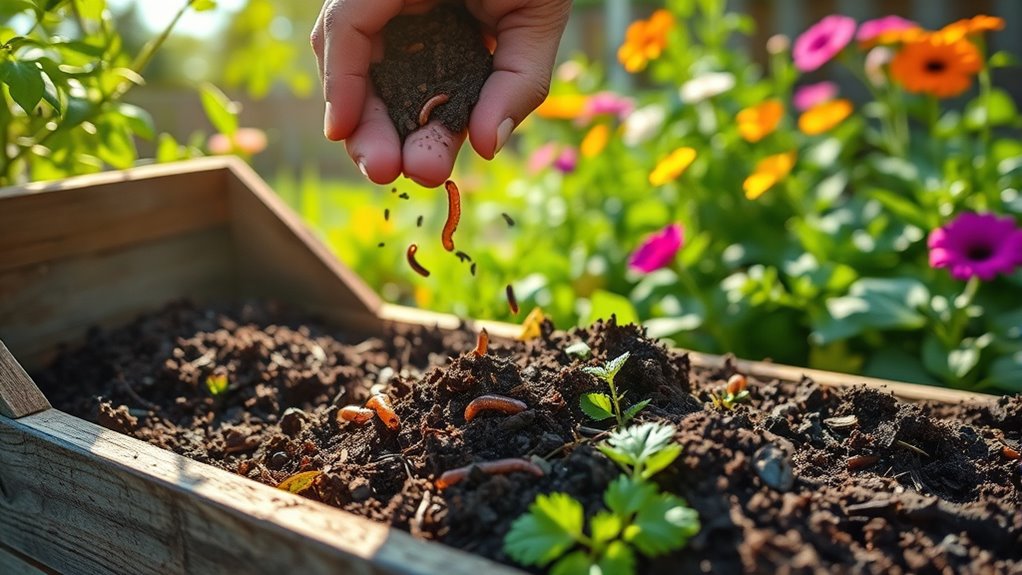
Using your finished compost in the garden is a simple way to boost plant health and soil fertility. Spread a layer of compost around your plants or mix it into the soil to enhance soil enrichment. This natural amendment provides essential nutrients that promote healthy root development and vigorous growth. Incorporate compost into garden beds before planting to improve soil structure and moisture retention. It also helps balance pH levels, creating an ideal environment for your plants. Regular use of compost reduces the need for chemical fertilizers, supporting sustainable gardening practices. By enriching your soil with compost, you encourage stronger plants, better yields, and a more resilient garden ecosystem. Overall, finished compost is a valuable resource for nurturing healthy, productive gardens.
Tips for Successful and Sustainable Composting
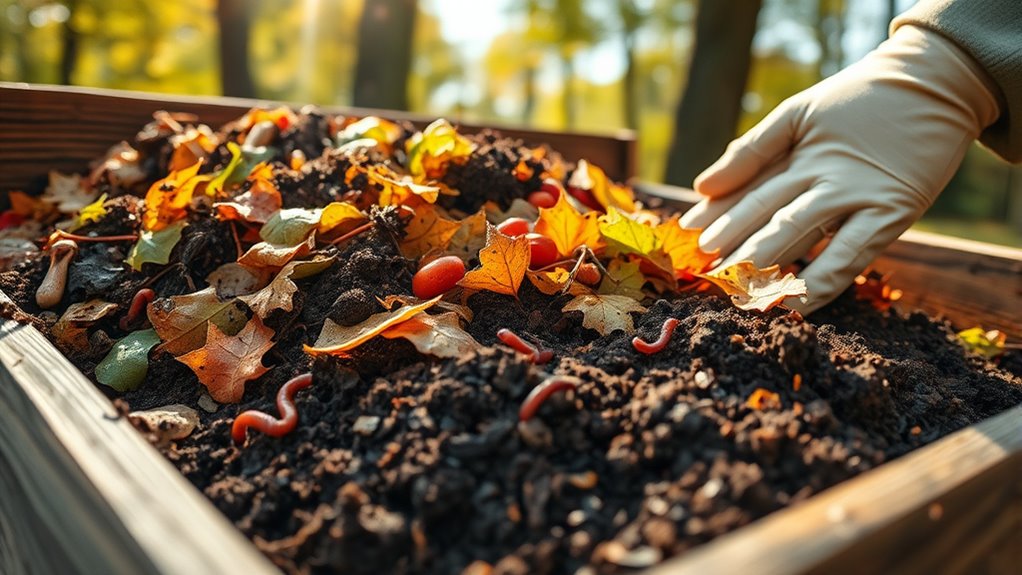
To guarantee successful and sustainable composting, start by balancing green and brown materials to maintain the right carbon-to-nitrogen ratio. This encourages healthy microbial activity and prevents odors. Incorporate worm composting to accelerate decomposition and enrich your compost with natural nutrients. Regularly aerate the pile to promote airflow and prevent compaction. Consider making compost tea from finished compost; it’s a powerful liquid fertilizer that boosts plant health. Keep your compost moist but not soggy for ideal decomposition. Additionally, layer your scraps thoughtfully, and avoid adding meat or dairy to reduce pests. Using a compost bin with a lid helps maintain moisture and temperature. Proper management ensures your compost remains sustainable and produces vibrant soil for your garden. Monitoring glycolic acid products and their benefits can inspire similar careful attention to detail in maintaining healthy compost conditions.
Frequently Asked Questions
How Long Does It Take for Compost to Be Ready?
You might wonder how long it takes for compost to be ready. Generally, it takes about 3 to 6 months, depending on factors like compost temperature and moisture management. Keeping the pile warm and moist accelerates decomposition. Turn it regularly to maintain proper airflow. When it looks dark, crumbly, and earthy-smelling, it’s ready to use. Monitoring temperature and moisture helps make certain a healthy, efficient composting process.
Can I Compost Pet Waste Safely?
Think of pet waste as a tricky guest at your compost party—welcome but with caution. You can compost pet waste safely if you use a dedicated, high-temperature compost bin and let it reach 140°F for several days. This kills pathogens and parasites, ensuring compost safety. Never add pet waste to your regular compost, as it risks contamination. Proper handling transforms waste into safe, nutrient-rich soil, but always prioritize safety first.
What’s the Best Way to Prevent Odors?
To prevent odors while composting, focus on odor control by maintaining proper aeration. Turn your compost regularly to guarantee oxygen flows freely, which helps break down materials efficiently and reduces unpleasant smells. Avoid adding too much moisture or food scraps that can cause odors. Use a well-ventilated bin and layer browns and greens properly. This combination keeps odors at bay and creates healthy, nutrient-rich soil.
How Do I Speed up the Composting Process?
To speed up composting, you should turn your composting bins regularly to aerate the material. Add a compost accelerator to boost microbial activity and break down scraps faster. Balance greens and browns for ideal decomposition, and chop organic materials into smaller pieces for quicker composting. Keeping the compost moist but not soggy also helps. These steps will help you see faster results in your composting process.
Are There Composting Methods Suitable for Small Spaces?
You can definitely find urban composting methods suitable for small spaces. Container methods are ideal because they don’t require much room and keep odors contained. Use a compact bin or a tumbler to easily manage composting in apartments or small yards. These methods are simple to set up, maintain, and are perfect for turning kitchen scraps into nutrient-rich soil without taking up too much space.
Conclusion
Think of composting as nurturing a tiny universe beneath your feet, where scraps transform into rich, dark soil. By embracing this process, you become a gardener of life, fueling your garden’s growth with your own effort. With patience and care, you turn waste into a vibrant foundation for your plants. So, start composting today and watch your garden flourish, like a lush oasis emerging from the fertile depths of your commitment.


